Gnats are minute sized flies ranging in length from 1/8 to 1/10 of an inch. Gnats have two wings and resemble more to a mosquito than to a fly.
In this article, we are going to see – Do gnats really bite or not. And if they bite, then we will also have a look at the symptoms and treatments for the same.
But before that, let’s educate ourselves a little bit more about Gnats.
As per Wikipedia, “A gnat is any of many species of tiny flying insects in the Dipterid suborder Nematocera, especially those in the families’ Mycetophilidae, Anisopodidae and Sciaridae“.
This means, a gnat is not a single species of an insect but it is a general name used for multiple species of flying insects. These species are:
- Fungus Gnats or Winter Gnats
- Eye Gnats or Eye Flies or Grass Flies
- Buffalo Gnats or Black Flies
- Sand Gnats or Sand Flies
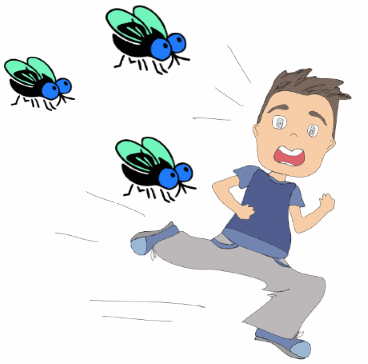
Now, let’s see do gnats really bite.
Do Gnats Bite?
The answer to this question is ‘Yes, some species of Gnats do bite.‘
The species in gnats that bite are called as ‘biting gnats‘ whereas others are called ‘non biting gnats‘.
Another important thing that is worth mentioning is that – ‘Only females in the biting gnat species bite. Males in those species feed on flower nectar and other plant juices.‘
Below is a table that can tell you which gnats bite and which don’t.
| Features | Fungus Gnat | Eye Gnat | Buffalo Gnat | Sand Gnat |
|---|---|---|---|---|
| Image | 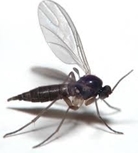 | 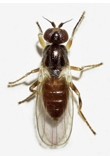 | 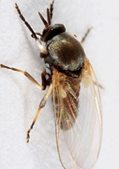 | 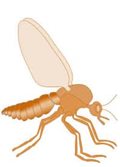 |
| Biting / Non-Biting | Non-Biting | Non-Biting | Biting | Biting |
| Size | 2 – 5 mm in Length | 1.5 – 3.5 mm in Length | 2 – 5 mm in Length | 1.5 – 5 mm in Length |
| Physical Appearance | They have blackish grey bodies with long gangly legs, multi segmented antennae. | They have shiny black or gray bodies and yellow to orange-brown legs. | They have black or greyish bodies, shiny thorax, short legs, and clear wings without scales. | Yellowish or brownish in color with hair all over their head, thorax, abdomen, and legs. |
| Special Features | Attracted to light | Attracted to eyes | Humpbacked appearance | Hairy wings in vertical ‘V’ shape |
From this table you can clearly see that – Buffalo and Sand Gnats bite whereas Fungus and Eye Gnats do not bite.
Note: An important thing here to note is – Gnats Bite but they do not sting like bees or wasps. You will hear people saying Gnats sting but that’s completely wrong.
Now, after understanding that some gnats do bite humans or animals, let’s see why they bite.
Recommended Reading: Facts about Horse Flies
Why do Gnats Bite?
Now, we know that only females in the biting species of gnats actually bite, whereas males primarily feed on nectar and flower juices.
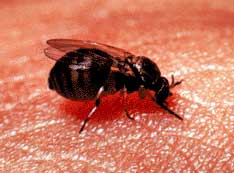
The females in the biting gnat species bite as they require a blood meal for effective reproduction. In order to create eggs, female gnats require protein. And to satisfy this protein need they require a blood meal for which they bite humans or cattle. After taking a blood meal within few days they get ready to lay 150 – 400 eggs.
It is seen that sometimes for a blood meal an adult female gnat can travel more than forty miles from aquatic breeding sites. Female biting gnats are attracted to carbon dioxide and black moving objects as this is the way how they find prey.
Check out this article: What Attracts Flies Into Your Home Or Surroundings?
How do Female Gnats Bite?
Female gnats have biting mouthparts, whereas males do not have them. The females have scissor or a jagged saw-like mouth that helps them to cut into skin and lap up the blood.
Unlike mosquitoes, they do not feed on blood by inserting a ‘snout’ in the victim’s body but instead, they use their ‘mandibles’ to cut a hole in the victim’s skin and feed on the blood.
During a bite, gnats release anticoagulants in the blood of the victim and this can cause mild to severe allergic reactions in sensitive individuals.
A typical gnat bite occurs in 4 stages:
- Stage 1: This stage is marked by the penetration of skin by mandibles.
- Stage 2: This stage involves the positioning the mouthparts in the wound. This involves anchoring the ‘syntrophium’ into the wound by means of the barbed ‘laciniae’.
- Stage 3: This is the stage where active feeding begins. The blood is pumped by three groups of muscles forming two functional pumps. These pumps are separated from each other and from other areas of the food canal. And hence this pumping process is a very complex and highly synchronized sequence of muscular contractions.
- Stage 4: This is the last stage in the feeding process and it involves the removal of ‘laciniae’ and hence disengagement of ‘syntrophium’.
Recommended Reading: How to Get Rid Of Sand Flies
How does a Gnat bite looks like?
A gnat bite looks like a pinprick with a tiny reddish spot in the middle and slight redness around the area along with moderate or low swelling. The bites are very painful and can result in skin itch and swelling for several days. Below are a few of the pictures of gnat bites that will help you to recognize them and differentiate them from the bite of other insects.
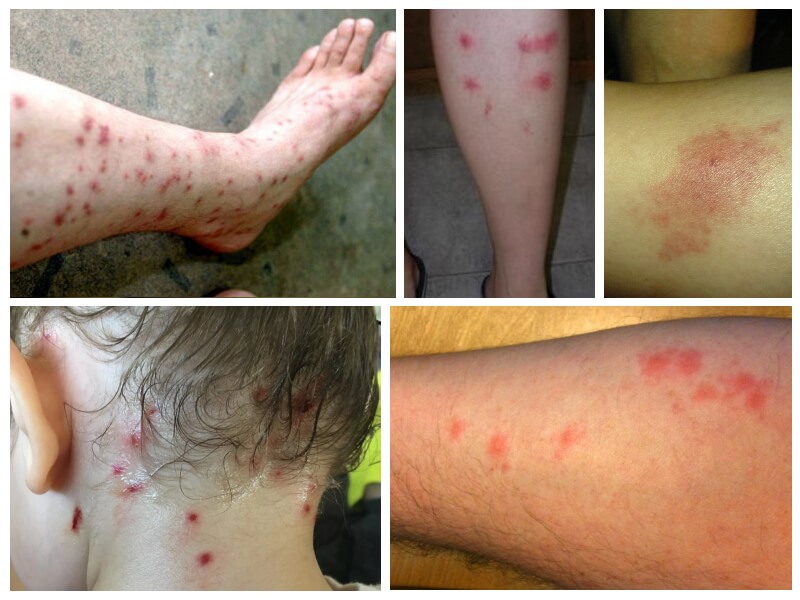
Does a Gnat bite Transmit diseases?
Not all gnats transmit diseases, but yes there are some that can transmit several diseases like:
- “River blindness” that causes infected individuals to lose sight.
- “Leishmania (Kala- Azar)” that causes cutaneous sores on the body.
- “Oraya” and “Sandly” Fever.
- Carrison’s disease.
- “Toscanca” and “Punta Toro” Virus.
Recommended Reading: 30+ Ways to Get Rid of Flies
Symptoms of a Gnat Bite:
Following are the symptoms of a gnat bite:
- Pain near the bitten area, along with redness, swelling, and itch.
- Some people may also experience skin irritation or burning sensation, as this is a reaction to the anti-coagulant that the gnats release in the wound.
- Unlike the bite of a fire-ant or a mosquito, in case of a gnat bite you may only see a small drop of blood where you were bitten.
- Some people may also experience fevers, few hours after the bite.
- Few people, less than 2% may also feel difficulty in breathing and or may break out in hives.
Recommended Reading: Best Homemade fly trap
Treatment for a Gnat Bite:
If a gnat as bitten you then you should follow below steps:
- Disinfect the area: This is the most important thing that you can do after a gnat has bitten you. Clean the area with soap and water thoroughly. You could also clean the area with any alcohol based or vinegar based disinfectant.
- Apply an Antiseptic: If you feel you can also apply an antiseptic swab over the wound. This is a good idea if you want the wound to heal quickly without any other complications.
- Anti-Itch or Pain relief: If you are experiencing a lot of pain of itch then you should visit a Doctor and he will prescribe you an anti-itch (antihistamines) or pain-relief medicine depending on your condition. Do not scratch the wound as it will open the wound for other bacterial infections.
- Know when to visit a Doctor: Visit a Doctor in case you experience any of the following symptoms after the bite:
- If the area around the bite is very swollen.
- If you have a hard time breathing, or get hive
- If you feel swelling of the throat, chest and mouth.
- If the wound begins to drain yellow or greenish fluid (pus).
How to protect yourself from Gnat Bites:
For this I have written a detailed article, you can read it here.
So, this was all about gnat bites and their treatment. Do let me know your ideas or opinions related to the topic.









